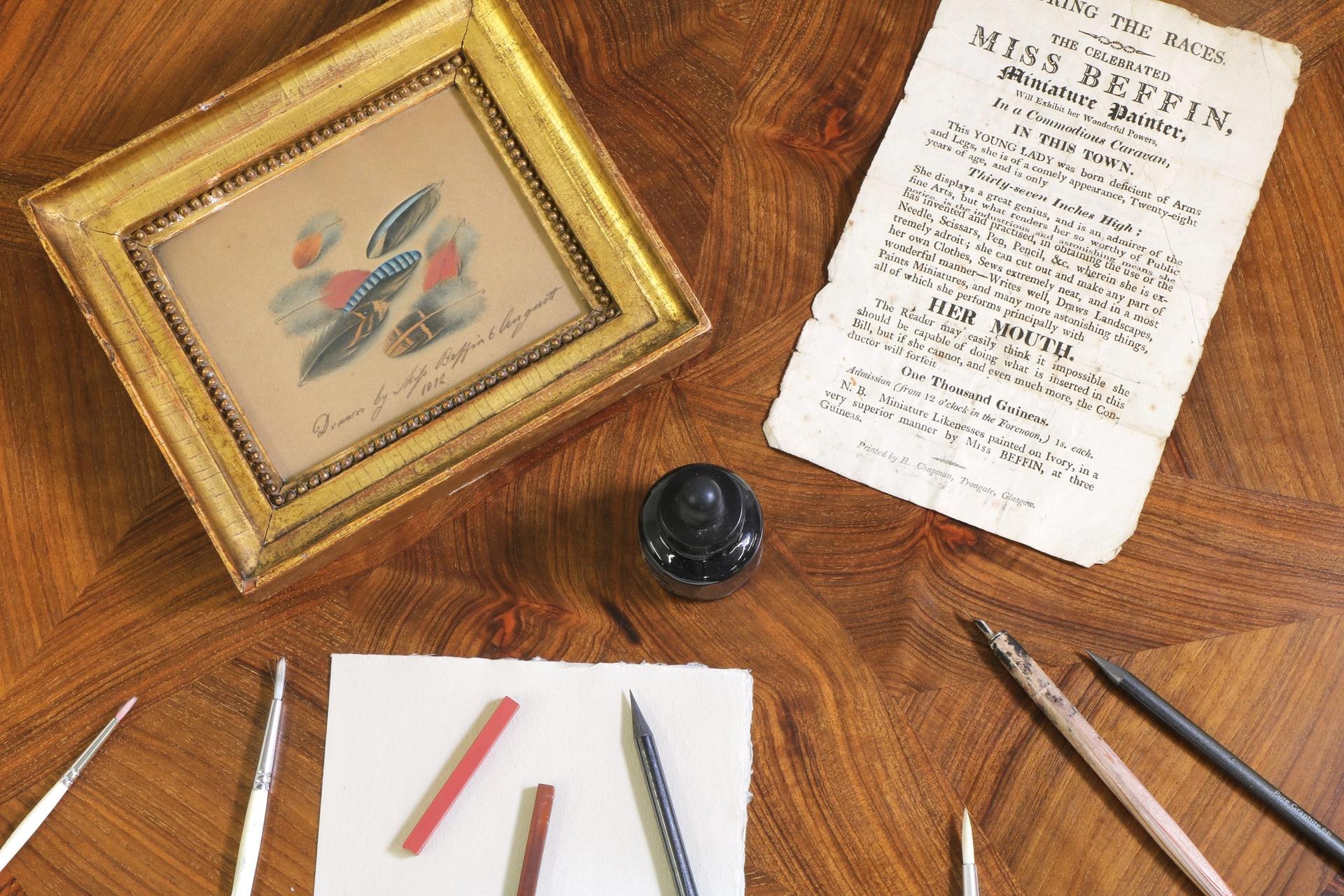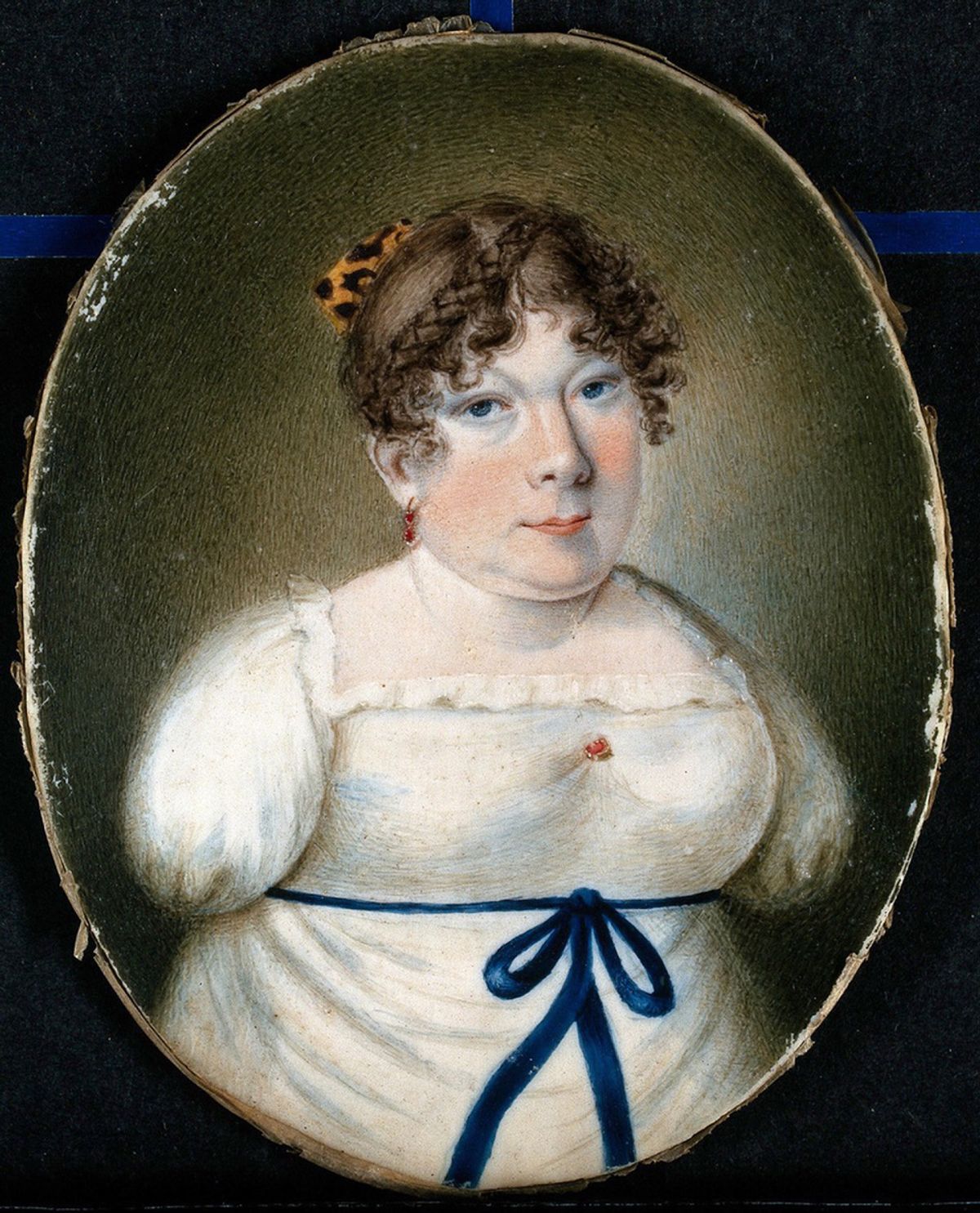Born in Somerset, England, in 1784 without arms or legs, by the age of ten, Sarah Biffin had taught herself to paint, write and sew using her mouth. By 13, she was earning £5 a year demonstrating her dressmaking and portrait painting skills as part of Emmanuel Dukes’ touring shows.
Though an unconventional start to her artistic career, in 1808 at St Bartholomew’s Fair, she was introduced to William, 16th Earl of Morton, who commissioned Biffin to paint a miniature portrait of himself, later sponsoring her to study at the Royal Academy of Arts. Other prestigious commissions came from George III, who purchased a portrait for his daughter, Queen Victoria, which is now in the Royal Collection. Another self-portrait resides in the Wellcome Collection.
Now, a rare watercolour study of feathers, inscribed in pen “Drawn by Miss Biffin, 6th August 1812”, is going under the hammer at Sworders auctioneers in Essex with an estimate of £3,000 to £5,000. It is being sold together with a handbill advertising her as an attraction “During The Races”, describing her as “born deficient of arms and legs, she is of comely appearance, twenty-eight years of age, and is only thirty-seven inches high”.
Sworders’ chairman Guy Schooling says he came across the watercolour hung behind a door in a bedroom of the former home of the late Cambridgeshire antiques dealer Peter Crofts, whose estate is being sold by the auction house.
In 1945, aged just 20, Crofts had both legs amputated below the knee after an accident training as a pilot in Florida. The engine of his Corsair F4U had burst into flames leaving him seriously injured. After three-and-a-half years in hospital, Crofts became an antiques dealer and by 1958 was elected a member of the British Antique Dealers Association. “Crofts obviously had this sympathy, this connection with Biffin, which was quite interesting,” Schooling says.
Celebrated during her lifetime—the English author Charles Dickens even referred to Biffin in his novels Nicholas Nickleby, Martin Chuzzlewit and Little Dorrit, though he often mocked her appearance—the artist fell into relative obscurity after her death in 1850.
But recently there has been renewed interest in Biffin’s pictures. “Her work is quite extraordinary by any standard,” Schooling notes. “She’s caught the zeitgeist, there’s a great resurgence in interesting female artists. And her prices are rocketing.”

Study of feathers by Biffin, together with a handbill advertising her as an attraction "During The Races"
Courtesy of Sworders
In December 2019, a self-portrait from around 1821 sold for a multi-estimate £110,000 (£137,500 with fees) at Sotheby’s. It had previously been sold by the firm in the 1980s, when it came to market with an estimate of £800-£1,200.
The art historian and portait miniature specialist Emma Rutherford wrote at the time: “I think the portrait represents much of what we admire today—a person with disabilities far more talented than many of her contemporaries, who, on the whole, would have been men. She represents such strength in overcoming not only the prejudice that would undoubtedly have been shown towards a professional female artist butA also towards someone who would have been viewed as a circus freak.”
In July, another study of feathers, more vibrant in colour than the Sworders picture, sold for £52,000 (£65,520 with fees) at Sotheby’s, against an estimate of £4,000 to £6,000.
Schooling says there has been “quite a lot of interest” from London for the Sworders lot. “Hers is such a young market, so we’ve estimated the picture quite conservatively. There seems to be one or two people who who have discovered her and are promoting her quite hard. So I think her star is rising,” he adds.
“I don’t know whether there are enough works to really create a market for her. But I think it’s lovely that after all these years, she’s still being remembered. And we’re still talking about her work 180 years later.”
Biffin’s picture is being auctioned tomorrow as part of Sworders’ fine interiors sale (14-15 December).


